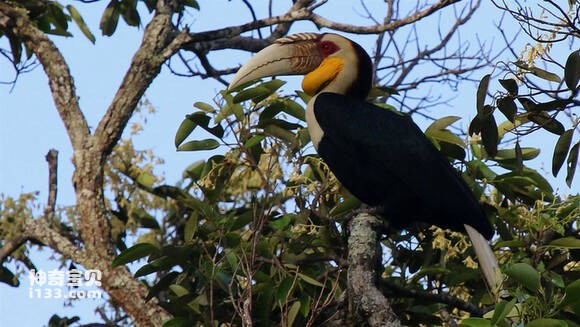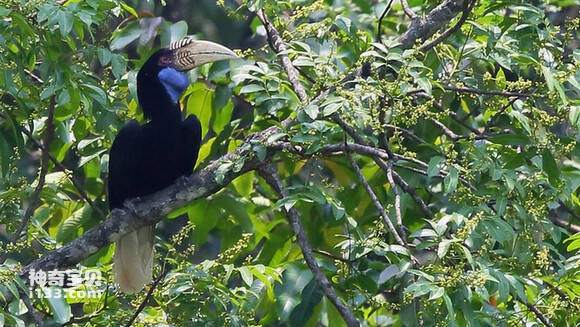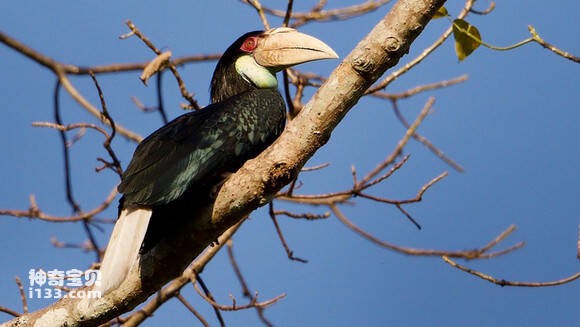Aceros undulatus
IUCN
LCBasic Information
Scientific classification
- name:Aceros undulatus
- Scientific Name:Aceros undulatus,Rhyticeros undulatus,wreathed hornbill,Bar-pouched wreathed hornbill
- Outline:Climbing birds
- Family:R.hornbills R.bicolor R.hornbill
Vital signs
- length:About 105 cm
- Weight:1-2kg
- lifetime:40-50years
Feature
The call is monotonous, hoarse, and like a dog barking
Distribution and Habitat
Origin: Bangladesh, Bhutan, Brunei, Cambodia, India, Singapore, Laos, Malaysia, Myanmar, Thailand, Vietnam, Indonesia (Sumatra, Java, Kalimantan and Bali).
In China, it appears in the areas of Xiashiti and Hongbeng River in Tongbiguan Township, Yingjiang County, western Yunnan. Male and female bird heads were found in rural houses in southwestern Yunnan (Tengchong). It may appear in southeastern Tibet.
It mainly inhabits subtropical evergreen broad-leaved forests at an altitude of 400~1500m, especially in wet evergreen broad-leaved forests along rivers.
Appearance
The female bird has a white tail and black body feathers, and has the same metallic green or purple-blue luster as the male bird. The skin of the throat pouch is bright dark blue, and there is also a black horizontal band on it.
The male iris is orange-red to blood red, and the exposed skin around the eyes is dark red to brick red. The iris of the female bird is brown or grayish brown. The beak is ivory yellow, with a dark orange-red base. The female's beak is also yellow. There are fine jagged notches on the edge of the mouth, and there is a relatively flat helmet process at the base of the upper mouth, with 6 wrinkles and bulges on it, forming a "wrinkled helmet". There are several oblique carvings on both sides of the mouth base, and the feet are green or slate black.
Size measurement: mouth peak ♂202~219 mm, ♀178~198 mm; wings 458~505 mm; tail 300~330 mm; tarsometatarsus 60~70 mm. (Note: ♂ male; ♀ female)
Details
The wreathed hornbill is called wreathed hornbill in foreign language, and has 2 subspecies.

The wreathed hornbill often moves in small groups of 3 to 5. The call is monotonous, hoarse, and like a dog barking, and sometimes it can also make a low two-syllable sound. It appears to be rather clumsy when flying, and the sound of its wings can be heard from a long distance. Sometimes it also enters the vicinity of villages and orchards to move around and forage.

The crowned hornbill is a resident bird. It mainly feeds on plant fruits, and also eats animal food such as tree frogs, bats, and lizards.

According to research in India, the breeding season of the crowned hornbill is from February to June. It nests in trees, especially in giant trees with dense trees. Each nest lays 2 to 3 eggs, sometimes only 1 egg. The eggs are white, sometimes stained with yellow, smooth and spotless. The size of the eggs is 49.5~72.5 mm × 38.0~47.1 mm according to the measurement of 24 eggs, with an average of 62.0 mm × 43.2 mm.

The global population of the crowned hornbill has not been quantified, but it is relatively common in some areas of its origin. Due to the continuous destruction and fragmentation of habitats, as well as the reduction of predation range, the population of this bird is on a downward trend.

The crowned hornbill was discovered in Yunnan. It was first discovered when two skull specimens were seen in the homes of local hunters. The scarcity of the bird population is related to the large-scale hunting by local hunters. It is reported that the population of this bird is also very scarce in India, because local people kill it in large numbers and sell it for medicinal purposes. Obviously, strengthening management and strictly prohibiting killing is crucial to protecting this bird.

Listed in the IUCN Red List: Least Concern (LC), assessed in 2012.
Listed in the "National Key Protected Wildlife List": National Second Class Protected Animal (effective December 10, 1988). (Note: Hornbill family, all species)
Listed in the "China National Key Protected Wildlife List" first class.
Protect wildlife and eliminate game.
Maintaining ecological balance is everyone's responsibility!








